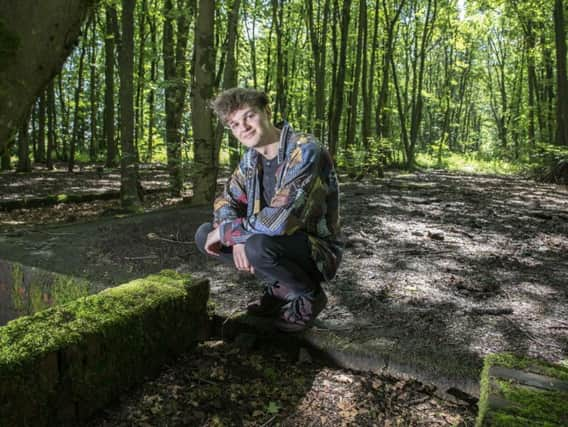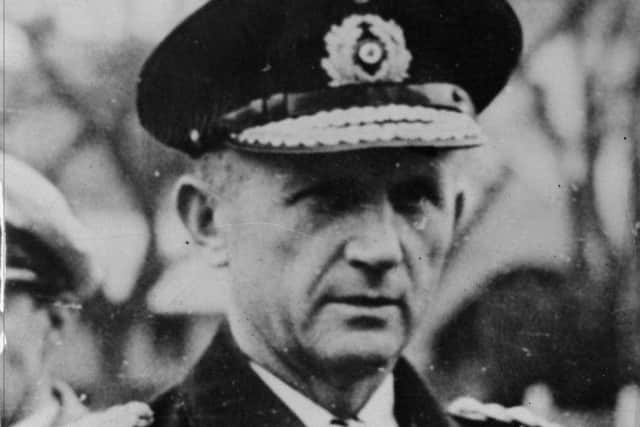What archaeology students have uncovered about 'forgotten' Second World War prisoner camp in Sheffield


The weathered brick remains that are tucked away in a wooded area on the edge of the Peak District National Park, provide little clue, on meeting the eye, to the story that they carry. In fact, despite its historical significance, it is a story few know much about.
But during the Second World War, the site was home to Britain’s biggest prisoner of war camp - and its smaller predecessor during the Great War conflict two decades earlier housed an inmate who would go on to succeed Adolf Hitler as President of the German Reich.
Advertisement
Hide AdAdvertisement
Hide Ad

“Nowadays, the site is popular with dog walkers and pedestrians just going for a stroll, who probably don’t know what the old building foundations are or that the site used to be a prisoner of war camp at all,” says archaeology student Rob Johnson.
“They’re not aware they are walking through the remains of what was once the largest prisoner of war camp in the UK.”
Archaeological research
Rob is part of a team at the University of Sheffield’s Department for Archaeology, which has been uncovering the site’s largely forgotten past.
Advertisement
Hide AdAdvertisement
Hide AdFor what is believed to be the first time, the remains of the camp have been the subject of archaeological fieldwork, studied alongside archival records and letters written by people who stayed there.
Students have surveyed the remains of the prison’s barracks and explored documents that reveal what living conditions were like at the camp in order to shine new light on the piece of Yorkshire’s history, that has been hidden in the countryside for decades.
“The prisoner of war camp was probably a very unpleasant place to stay,” says Rob.
“The prisoners were fed food out of galvanised dustbins, had to stand outside in the mud, rain and cold for several hours a day during roll call, and, since it was so overpopulated as a transit camp, they were squashed into tents or the barracks with little personal space.”
Crowded conditions
Advertisement
Hide AdAdvertisement
Hide AdAt its peak in 1944, the camp, known as Lodge Moor, held more than 11,000 people, including the most fanatical of prisoners. Many inmates came from Germany, Italy and Ukraine.
“At the beginning, we see the camp occupied by mostly Italian prisoners,” explains fellow student Charlie Winterburn. “They were employed on the nearby farms as labour to make up a shortfall common during the war effort.
“Coincidentally, we learned of a family that had positive relations with the Italian prisoners and gave them tea, sharing what little they had with the labouring Italians.
“This comes to the end as the war drags on and more Axis soldiers (from the German, Italian and Japanese nations that fought against the Allies) are taken captive - the camp becomes much more prison-like and the quality of life goes down.
Advertisement
Hide AdAdvertisement
Hide Ad“The number of prisoners per barrack is often listed at around 30 in official records.
“However, we studied the writings of Heinz George Lutz, a former prisoner of the camp, that we uncovered in the libraries of Sheffield, and he gives us an entirely different number.
“He suggests that there were upwards of 70 prisoners per barrack and all of a sudden, things look more terrible for the prisoners.”
The camp would be visited on occasion by humanitarian organisation the International Committee for the Red Cross, which would publish reports on standards there.
Advertisement
Hide AdAdvertisement
Hide AdOne said the camp’s leader did not care very much for repatriates and another, several years later in 1948, deemed him to be a “selfish amateur”.
Escape attempts
It is perhaps not surprising then that there were several escape efforts, including from a group of German prisoners, who fled on December 20 1944, making it to Rotherham before being captured without a fight 24 hours later.
But it was in the First World War, when the camp was much smaller in size, that it held - and lost - its most famous prisoner.
Admiral Karl Doenitz, the captain of several German U-boats, was captured by the Allied Forces when his vessel encountered technical difficulties and was forced to surface on October 4, 1918.
Advertisement
Hide AdAdvertisement
Hide AdHe spent around six weeks at the camp, off Redmires Road in Sheffield, later that year and during that time, researchers say he plotted his escape by feigning mental illness to avoid being tried as a war criminal.
His deception fooled the guards and he successfully tricked his way out of captivity, spending the rest of the war at Wythenshawe Hospital in Manchester, where he was transferred for specialist treatment.
At the end of the Second World War, he briefly succeeded Hitler as head of the state of Nazi Germany.
Life after the war
For some of Lodge Moor’s prisoners, life after the war involved staying in Britain, with several becoming UK citizens.
Advertisement
Hide AdAdvertisement
Hide Ad“Some of them decided to stay in Sheffield,” explains Samuel Timson, who has worked on the project. “For example, we found a newspaper interview with a former prisoner who became a nurse.”
As for the site itself, it is thought it was active for around three years after the war came to an end, before being abandoned.
“Pretty much all of them were abandoned,” Rob says. “They weren’t put together with much organisation - it was just that there was a lot of prisoners flooding in and they had to put them somewhere. After the war, they didn’t really know what to do with the sites.”
Tucked away
Today, Lodge Moor remains all-but covered amongst trees, hiding, as one member of the research team, Georgina Goodison, puts it, the secret of all the thousands of men housed there merely decades ago.
Advertisement
Hide AdAdvertisement
Hide Ad“It was a big eye opener for me, as I didn’t realise that Lodge Moor camp even existed,” she says. “I have really enjoyed the idea of the project, to bring local history back to life and remind the people of Sheffield what actually happened here during the war.”
“It seems quite peaceful, like the rest of the countryside,” Rob adds. “But after doing all that research and knowing what we know now, it is quite eerie to travel there.
“Once you know that, it does change your perspective of it, to imagine what went on there. It was described as one of the most unhappy of all the prisoner of war camps.”
The findings of the archaeological and archival study will be presented to Sheffield City Council and the Sheffield Lakeland Landscape Partnership, which aims to conserve and celebrate the natural, built and cultural heritage of the north-west of the city.
Advertisement
Hide AdAdvertisement
Hide AdThe students involved hope their findings can be used to preserve and restore the site and surrounding woodland and share its story for generations to come.
Training site
According to Historic England, during the First World War, the site was known as Redmires Camp and was used as a training facility for the Sheffield Pals battalion.
Initially the men trained at the Bramall Lane football ground but in December 1914, they moved to the camp, where training included digging different types of trenches and erecting simple shelters.
The battalion became part of a division which on July 1, 1916 was involved in the Somme offensive.
Advertisement
Hide AdAdvertisement
Hide AdBut by July 3, when the remnants of the battalion were taken out of the line, 513 officers and men had been killed, wounded or gone missing.
The Historic England listing of the site says there is no indication the training area was reactivated during the Second World War.